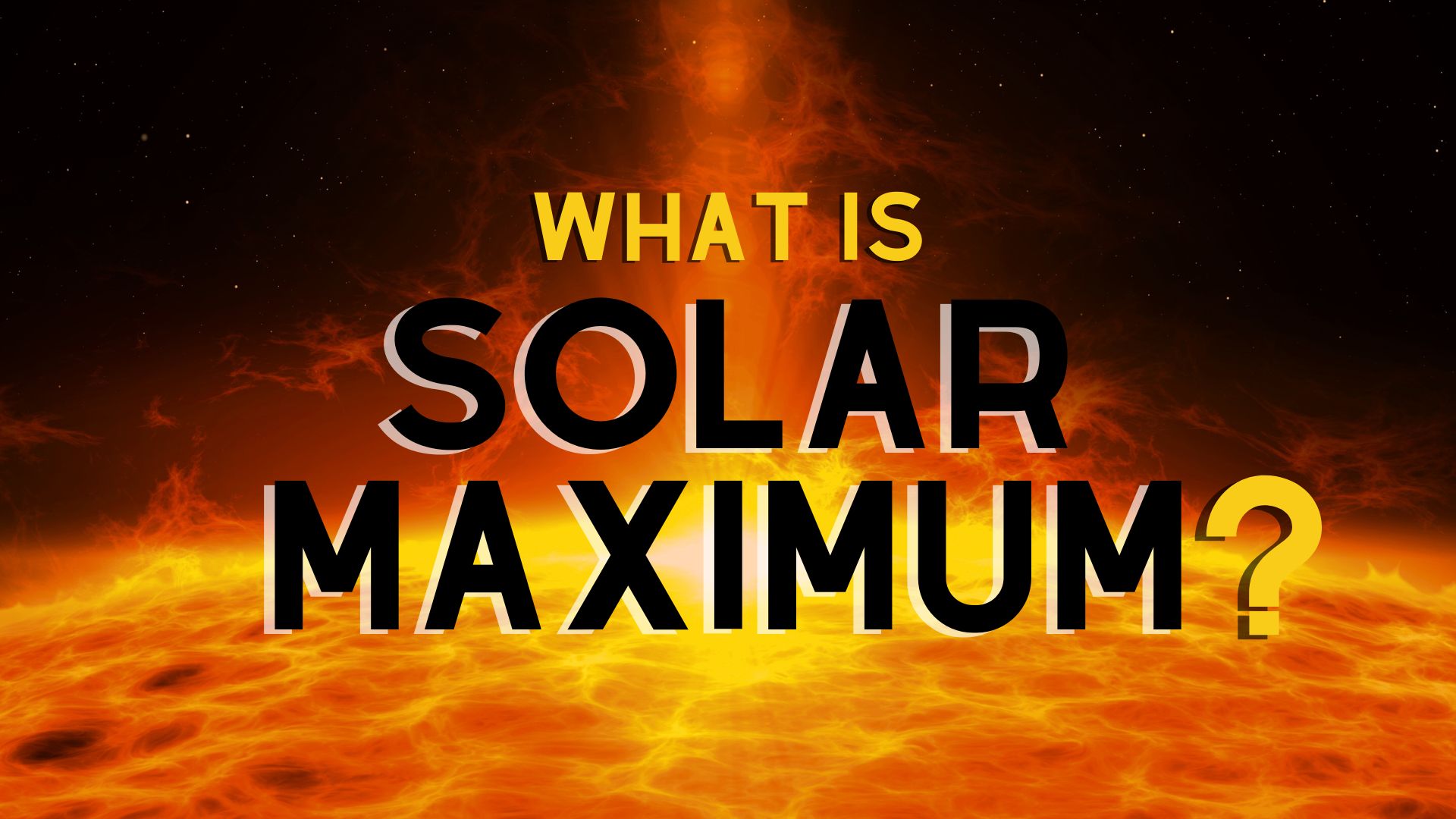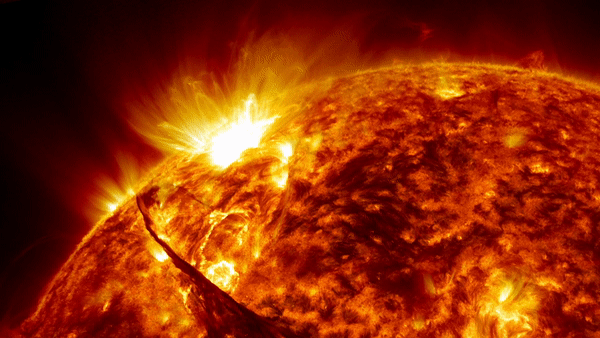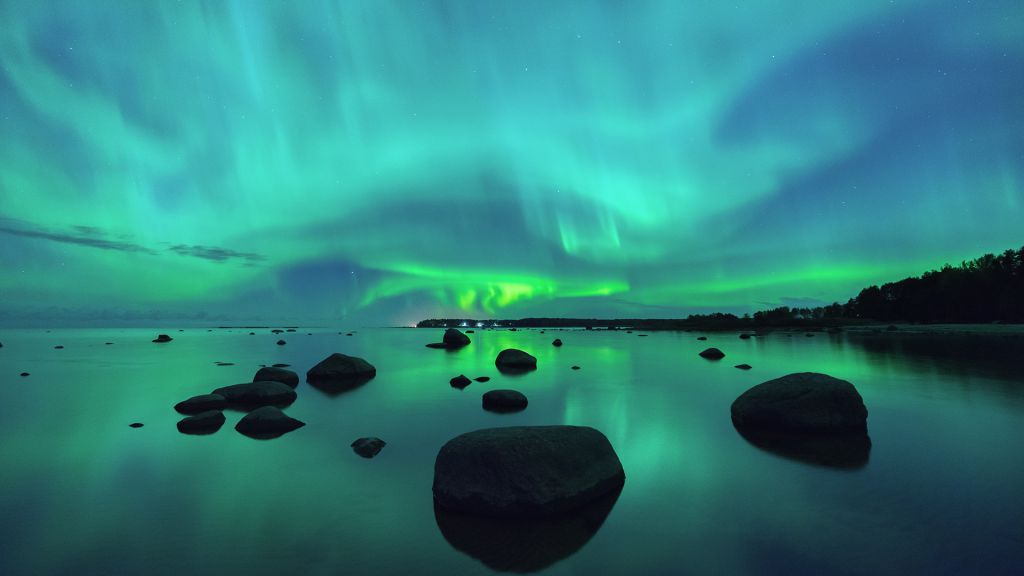What is solar maximum and when will it occur?
Solar maximum is officially here, but what exactly does that mean?

Solar maximum refers to the highest rate of solar activity during the sun's approximately 11-year solar cycle. It is indicated by the intensity and frequency of sunspots visible on the surface.
On Oct. 15, 2024, representatives from NASA and the National Oceanic and Atmospheric Administration's (NOAA) Space Weather Prediction Center (SWPC) announced that the sun has entered its solar maximum period which could continue for another year.
Solar minimum is the opposite of solar maximum and marks the lowest rate of solar activity during a given solar cycle.
Solar maximum FAQs
What is solar maximum?
Solar maximum refers to the highest rate of solar activity during its approximately 11-year solar cycle.
When was the last solar maximum?
The last solar maximum was reached in April 2014 according to the World Data Center for the Sunspot Index and Long-term Solar Observations (SILSO), it was part of Solar Cycle 24.
Is solar maximum happening now?
We are currently experiencing the solar maximum period for Solar Cycle 25. "While the Sun has reached the solar maximum period, the month that solar activity peaks on the Sun will not be identified for months or years," said Elsayed Talaat, director of space weather operations at NOAA in a press statement.
Solar maximum 2024

We are currently experiencing the solar maximum period for Solar Cycle 25. But this doesn't mean that this month is the peak of solar activity, for that title, we'll have to wait a little longer.
Predicting when the peak of solar activity will occur is no mean feat. Scientists compute solar maximum through careful analysis of the frequency of sunspots visible on the sun's surface. The previous solar maximum for Solar Cycle 24 occurred in April 2014.

"The maximum is computed (as a convention) with the 13-month smoothed sunspot number (which means that for each month you use the value of six months before and six months after)," ESA’s SSA Space Weather Coordination Centre (SSCC) solar expert service center told Space.com in an email. "The exact value of this quantity for time T is known only 6 months later" the SSCC solar scientists continued.
For example, let's say solar maximum did occur in October 2024. Scientists would need sunspot number data from the previous six months, the month of October 2024 and the next six months which would take us to April 2025. So we would have to wait until May 2025 to be able to declare that solar maximum had occurred in October 2024.
And sometimes just when we think we've got it all figured out, the sun can fool us! Increased solar activity can sometimes turn out to be what is known as a 'local maxima' and not representative of the entire solar cycle. Sunspot cycles can also experience 'double maxima', called a Gnevishev's gap, which means that the first peak might not be the highest and another large peak can follow.
All of this means we could have some time to wait before we know exactly when Solar Cycle 25's solar maximum has occurred.
Does solar maximum affect the northern lights?

The northern lights (aurora borealis) and the southern lights (aurora australis) are created when energized particles from the sun hit Earth's atmosphere and are funneled toward the poles by our planet's magnetic field. As the particles are redirected toward the poles, they interact with our atmosphere, by depositing energy and causing the atmosphere to fluoresce. During times of heightened solar activity around solar maximum, a greater amount of energized particles can be emitted from the sun, through large expulsions of plasma and magnetic fields known as coronal mass ejections (CMEs), solar flares and increased solar wind. These energized particles can trigger geomagnetic storms, also known as solar storms — large disturbances in Earth's magnetosphere which, in turn, can lead to stronger aurora displays.
You might have seen various media outlets claiming "THIS is the year for the northern lights, book now for the BEST displays!" or something to that effect. While it is true that heightened solar activity can lead to more dynamic aurora displays, it is somewhat misleading to claim that this year is THE time to see them because of 'solar maximum'.
Firstly, we still don't know when solar maximum will occur, so for all we know, solar activity could still ramp up until early 2026 according to NOAA's SWPC estimates. Solar maximum is also not a single moment in time and can last for years. When scientists calculate the 'absolute maximum' it refers to the moment the sun's magnetic field flips and indicates the halfway point, with half of the solar maximum over and half still to come.
Related: The next 4 to 5 years will be the best time to see the northern lights this solar cycle
Secondly, auroras are visible at any time in the solar cycle, even during solar minimum. The sun doesn't stop bombarding us with energetic particles just because its activity has reduced. For example, the last solar minimum — when the sun is least active — occurred in December 2019. In the same year, several months earlier on March 26, photographer Miguel Claro captured this stunning display of springtime auroras. This is evidence that even during periods of weakened solar activity, it's still possible to see a truly remarkable sight.
And last but not least, auroras are fickle creatures, you can have the perfect geomagnetic conditions and fail to see a show, or it can be in the middle of solar minimum and suddenly the skies light up with an exquisite display. So while heightened solar activity over the next few years increases your chances of seeing the northern lights, you need to be aware that this is not a guarantee nor does it mean you can't see them at any other time during the solar cycle.
Related: Where and when to see the northern lights in 2024
Solar maximum expert Q&A
We spoke with Mark Miesch, space weather research scientist at NOAA's Space Weather Prediction Center (SWPC) about solar maximum.
Mark Miesch is a research scientist and member of the solar and solar wind modeling team at NOAA's Space Weather Prediction Center (SWPC)
How was the solar cycle discovered?
Humanity has known for over 2,000 years that the sun sometimes has dark spots on it that we call sunspots (best viewed now with a solar telescope — don't look directly at the sun!). More than 150 years ago, scientists noticed that the average number of sunspots rises and falls approximately every 11 years. We call this the solar cycle.
What happens during solar maximum?
Solar maximum is the peak of the solar cycle — when the average number of sunspots is larger than at any other time during the cycle. So, it happens roughly every 11 years but the time between solar maxima can be as short as 9 years or as long as 13 years. The last solar maximum was in 2014 and we expect the next solar maximum to occur a little earlier than average, in 2024.
How long does solar maximum last?
Though solar maximum is often referred to in terms of the month where the sunspot number peaks, the associated period of high activity lasts longer than that — from one year to over two years. So, in the current solar maximum, we expect high levels of solar activity throughout 2024 and likely into 2025.
What does solar maximum mean for us on Earth? Is it dangerous?
We now know that sunspots are a magnetic phenomenon and that magnetic fields have energy.
When that magnetic energy is released explosively, it can power colossal solar storms known as solar flares and coronal mass ejections (CMEs). When the effects of those storms reach Earth, they can damage electrical power grids, disable satellites, disrupt radio communications and GPS navigation, and endanger astronauts brave enough to venture outside the protective confines of Earth's atmosphere and magnetosphere.
Though a large solar storm has the potential to be a natural disaster on the scale of a hurricane, most average citizens don't have to worry much about space weather. If we do our jobs right in forecasting solar storms and if the power companies, satellite companies, airlines and other industries do their jobs in responding to them, then most people will not notice much of a difference between solar minimum and solar maximum. That is, unless you live at high latitudes, where the enhanced activity around solar maximum will produce celestial light shows that we call the aurora.
Additional resources
Check out NOAA's Space Weather Prediction Center (SWPC) for official space weather forecasts for the U.S. Explore more about space weather impacts with NOAA's SWPC. See the solar cycle like never before with this impressive composite image from the Solar and Heliospheric Observatory (SOHO), which shows changes in the sun's appearance over the solar cycle. If you're an avid aurora chaser or want to learn more about sightings all over the world, Aurorasaurus is a citizen science site where you can report your aurora sightings and also learn more about auroras with their informative blog.
Bibliography
2014 : Maximum year for solar cycle 24. SIDC. (n.d.-a). https://www.sidc.be/SILSO/news004
Daily and monthly sunspot number (last 13 years). SIDC. (n.d.-b). https://www.sidc.be/SILSO/dayssnplot
Solar cycle progression. NOAA / NWS Space Weather Prediction Center. (n.d.). https://www.swpc.noaa.gov/products/solar-cycle-progression
US Department of Commerce, N. (2020, September 15). Hello solar cycle 25. National Weather Service. https://www.weather.gov/news/201509-solar-cycle
What is the solar maximum. Aurora Zone. https://www.theaurorazone.com/about-the-aurora/the-science-of-the-northern-lights/what-is-the-solar-maximum
Join our Space Forums to keep talking space on the latest missions, night sky and more! And if you have a news tip, correction or comment, let us know at: community@space.com.
Get the Space.com Newsletter
Breaking space news, the latest updates on rocket launches, skywatching events and more!

Daisy Dobrijevic joined Space.com in February 2022 having previously worked for our sister publication All About Space magazine as a staff writer. Before joining us, Daisy completed an editorial internship with the BBC Sky at Night Magazine and worked at the National Space Centre in Leicester, U.K., where she enjoyed communicating space science to the public. In 2021, Daisy completed a PhD in plant physiology and also holds a Master's in Environmental Science, she is currently based in Nottingham, U.K. Daisy is passionate about all things space, with a penchant for solar activity and space weather. She has a strong interest in astrotourism and loves nothing more than a good northern lights chase!










